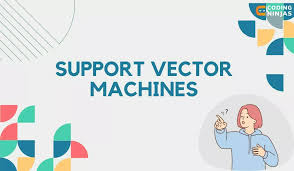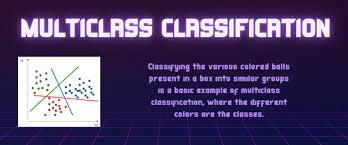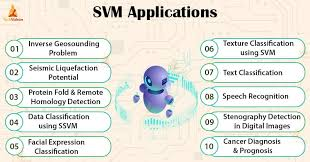A Deep Dive into Support Vector Machines (SVM): Algorithm, Optimization, and Applications 2024
Support Vector Machines (SVMs) are one of the most powerful and versatile algorithms for supervised learning, particularly suited for classification tasks. Originally developed by Vladimir Vapnik in 1992, SVMs have since become a cornerstone in machine learning, offering exceptional accuracy and generalization performance, especially in complex real-world applications.
In this blog, we’ll explore the intuition behind SVMs, the optimization process, the kernel trick, and some of the real-world applications of SVMs.
Motivation and History of SVM

SVM was introduced as a more efficient alternative to Neural Networks (Perceptron models). Before the introduction of SVM, neural networks were the most commonly used machine learning technique, but they had several limitations, including the issue of local minima in training. In contrast, SVMs are capable of avoiding these pitfalls, offering a more robust solution that generalizes well on unseen data.
SVM became popular after its success in applications such as handwritten digit recognition, where it showed an accuracy comparable to sophisticated neural networks. It was particularly recognized for its ability to perform well with small training sets and in high-dimensional spaces.
The Problem Definition in SVM

Given a set of data points belonging to one of two classes, the goal of SVM is to find a hyperplane (decision boundary) that best separates these two classes. For linearly separable data, this means that there is a hyperplane that divides the points of one class on one side and the points of the other class on the opposite side.
Mathematical Formulation of SVM:
- We are given nnn data points where each data point is a vector of length mmm and belongs to one of two classes: labeled as +1 and -1.
- The task is to find a hyperplane that separates these classes while maximizing the margin between the classes.
Choosing the Optimal Hyperplane
In theory, there are multiple hyperplanes that can separate the two classes. However, SVM aims to choose the one that maximizes the margin between the closest points from each class, known as the support vectors.
- Support Vectors: These are the data points that are closest to the decision boundary and directly affect the position and orientation of the hyperplane.
- Margin: This is the distance between the hyperplane and the support vectors. The larger the margin, the better the generalization to unseen data.
SVM works by maximizing this margin, which leads to better performance when classifying new, unseen data. A larger margin indicates less chance of error, making the SVM model more robust to noisy data.
Optimization in SVM: The Objective
The main goal in SVM is to find the optimal separating hyperplane that maximizes the margin. This is done by solving an optimization problem that involves the following:
- Objective: Maximize the margin γ\gammaγ, which is twice the distance ddd between the hyperplane and the support vectors.
- Constraints: Ensure that the data points from the two classes are correctly classified:
- If yi=+1y_i = +1yi=+1, then w⋅xi+b≥1w \cdot x_i + b \geq 1w⋅xi+b≥1.
- If yi=−1y_i = -1yi=−1, then w⋅xi+b≤−1w \cdot x_i + b \leq -1w⋅xi+b≤−1.
The solution involves finding the values for the weights www and bias bbb that satisfy these constraints while maximizing γ\gammaγ. This optimization can be solved using quadratic programming techniques.
The Kernel Trick for Non-Linear Classification
One limitation of SVM is that it works best when the data is linearly separable. However, in many real-world problems, the data is not linearly separable. This is where the kernel trick comes into play.
The Kernel Trick:
The kernel trick maps the input data to a higher-dimensional space where it becomes linearly separable. This allows SVM to work in non-linear spaces while avoiding the computational cost of explicitly transforming the data. Common kernel functions include:
- Polynomial Kernel
- Gaussian Radial Basis Function (RBF) Kernel
- Sigmoid Kernel
Using the kernel trick, SVM can efficiently find the optimal hyperplane even in higher-dimensional spaces, making it a versatile tool for a wide variety of data types.
Soft Margin SVM for Handling Noise
In real-world datasets, perfect separation of classes is often not possible due to noise and outliers. To address this, SVM introduces the concept of a soft margin, which allows some misclassifications by introducing slack variables.
- Slack Variables: These represent the degree to which a data point is misclassified. The soft margin SVM balances between maximizing the margin and minimizing the classification error.
- Penalty Parameter (C): This parameter controls the trade-off between maximizing the margin and minimizing classification error. A larger value of CCC gives more importance to reducing classification errors, potentially leading to overfitting. A smaller CCC allows for a larger margin but may lead to underfitting.
SVM for Multi-Class Classification

While SVM is fundamentally a binary classifier, it can be extended to handle multi-class classification problems. There are two common approaches for multi-class classification with SVM:
- One-vs-All (OvA): Train one classifier for each class, where the class of interest is treated as the positive class and all other classes are treated as negative. The class with the highest confidence score is chosen as the predicted class.
- One-vs-One (OvO): Train one classifier for every pair of classes. In this case, the decision is made by voting across all the classifiers, and the class with the most votes is selected.
Applications of SVM

SVMs have found applications in various fields, including:
- Handwritten Digit Recognition: One of the first major successes of SVM was in recognizing handwritten digits with a high accuracy rate. SVMs were able to match the performance of complex neural networks.
- Facial Expression Recognition: SVM is used to classify facial expressions, such as anger, disgust, joy, and sadness, based on the position of facial features.
- Text Classification: SVM is widely used for text classification tasks, such as spam detection and sentiment analysis, due to its effectiveness in handling high-dimensional data.
Conclusion: The Power and Limitations of SVM
SVM is a powerful machine learning algorithm that excels at classification tasks. By maximizing the margin between classes and using kernels to map data to higher dimensions, SVM can handle both linear and non-linear classification problems. However, it is computationally expensive and requires careful tuning of hyperparameters such as CCC and the choice of kernel.
Despite these challenges, SVM remains one of the top choices for many classification problems due to its robustness and ability to generalize well on unseen data.